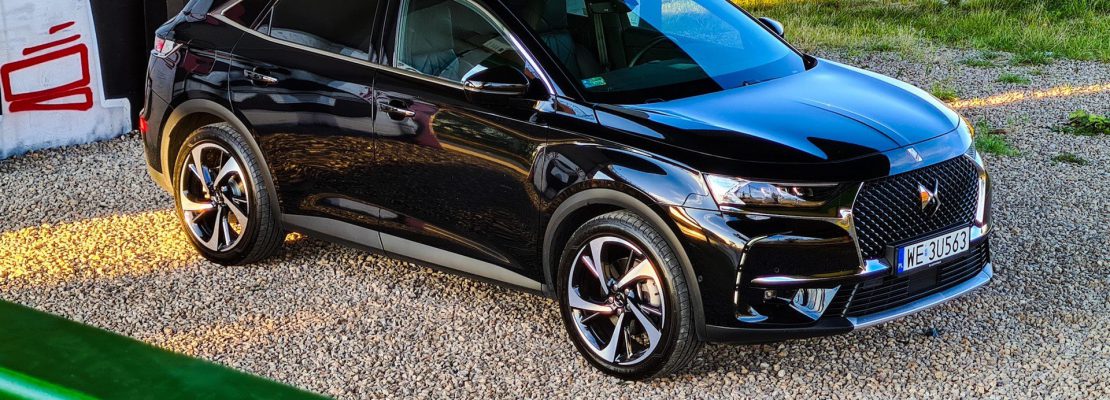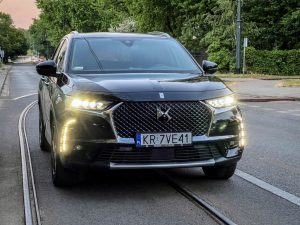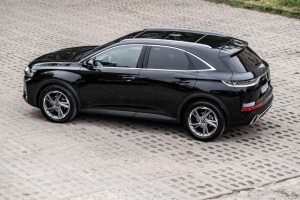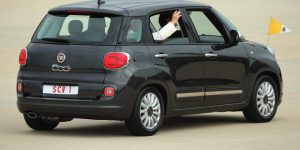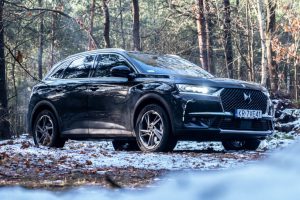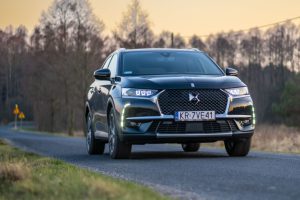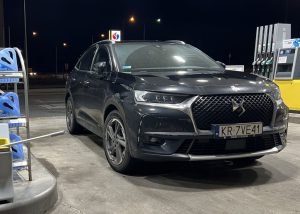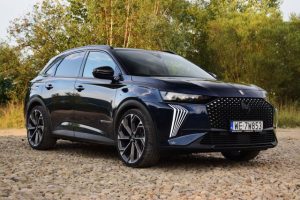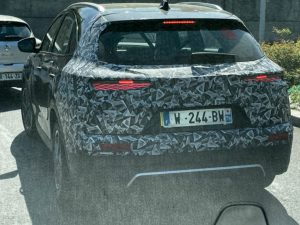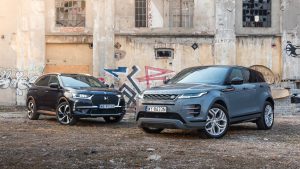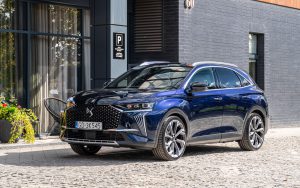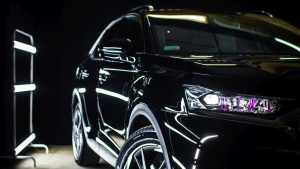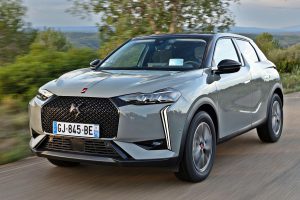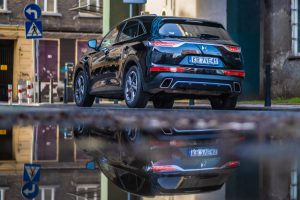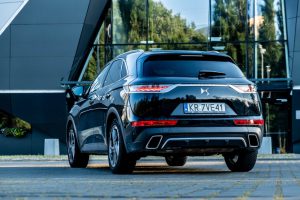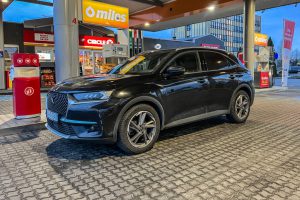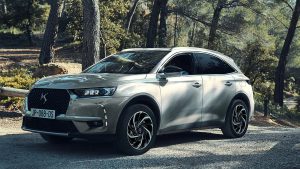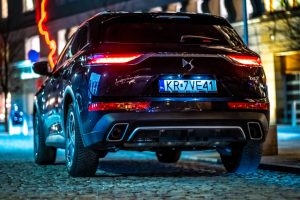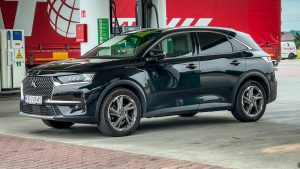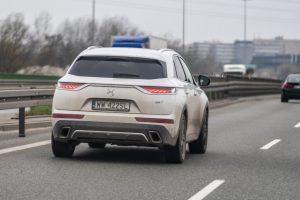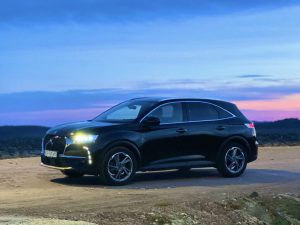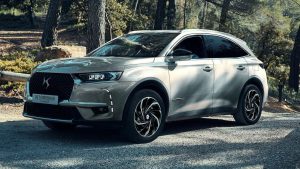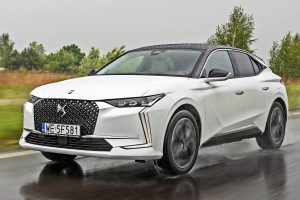This is my next meeting with the DS 7 Crossback and every time I collect a set of faults for this car, after a while a strange nostalgia appears and all the annoying features cease to be important. It is not a perfect car and it is far from it, but it cannot be denied that the French proposal from the premium segment has something about it that attracts people and plays a bit of emotion. How does the more powerful DS 7 Crossback perform in everyday use and does the plug-in mix make sense?
Photo by Kamil Rogala
The DS 7 Crossback is a technical relative of the Peugeot 3008, Citroen C5 Aircross and Opel Grandland, but it must be admitted that the DS proposal looks better. The car has been on the market since March 2017, but it still makes an impression and looks simply amazing. It is true that the DS 9 (recently tested) and DS 4 have appeared recently and are receiving a lot of praise for their design, but the hero of this test has no shortage of things that arouse admiration. Of course, the most amazing thing is still the headlights and the amazing concert they play when starting the car (including opening / closing it after dark). The taillights also have good internal graphics and attract attention. The front end also has vertical LED daytime running lights, which match well with the three LED squares in the headliners. There was also a lot of chrome in various parts, front and back. The sideline also looks good, there are lots of nice accents and embossing, although there is a lack of retractable door handles and automatic return.
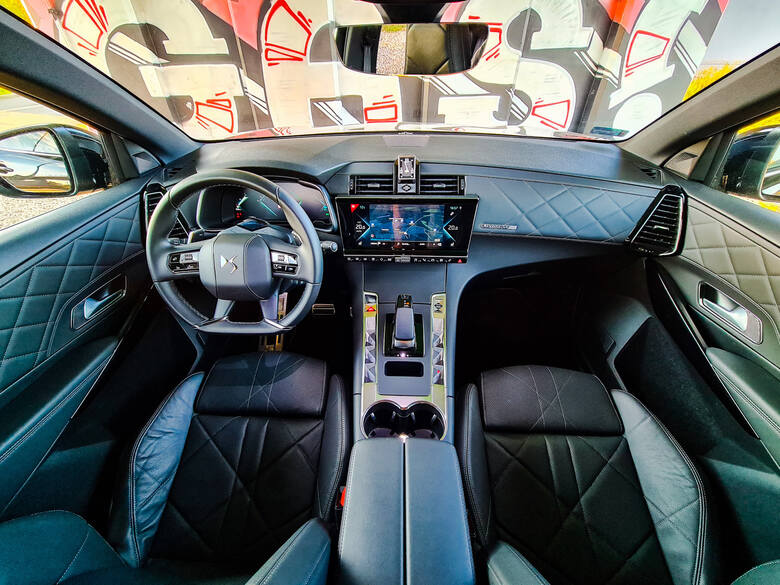
Photo by Kamil Rogala
The interior of the DS 7 Crossback is similar to the DS 9. The center console has cups, a small compartment, for example for important or small items, a gear lever known from other models and two rows of stylized switches to open the windows, close the central , etc. It looks very good. Above is the widescreen infotainment system, just above that is the ignition button and the BRM clock, which hides when the ignition is off. The test car was equipped with a basic package and leather upholstery, which had an interesting rhomboid stitching on the seats, panels in front of the driver and door panels. Options include packages with leather upholstery, which – in my opinion – do not have such attractive stitching. Of course, the online dashboard landed in front of the driver’s eyes. Everything fits perfectly and is made of very good materials, but I have a feeling that in the DS 9 it was better, especially in the lower parts of the central tunnel.
There is certainly a lot of space and comfort, although ergonomics is not the biggest advantage of the DS 7 Crossback. The engine start button is very high and far away, and moreover, after pressing the button you have to hold it for 2 seconds to start the engine. There is a similar delay when turning off the car. It’s a little annoying. You also need to get used to the location of the switch to control the windows and lock. The hazard warning light button is at the very end of the window at the bottom of the screen. A small mirror control panel is located under the left windshield behind the steering wheel, so the mirrors need to be changed several times. Well, aesthetics and original style have their own rules. The trunk capacity is a respectable 555 liters, and after folding the rear seats, the space increases to 1,752 liters.
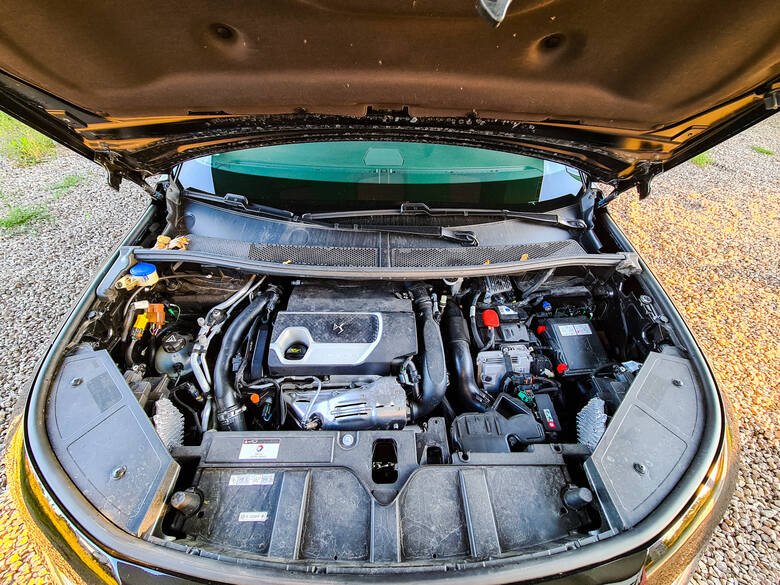
Photo by Kamil Rogala
I recently tested a DS 9 with the base 1.6 PureTech 224 HP petrol engine equipped with Performance Line+. It was the basic model in the version (at the time) and, in my opinion, the best. The engine handled the limousine with a length of almost 5 meters well, it had good fuel consumption and the range provided by the standard 62-liter tank. Indeed, there was no question of sports feelings or power measurements with German competitors, which could hide the V6 or large units under the hood, and the car adopted all-wheel drive. In the DS 7 Crossback with the top drive unit, namely the 1.6 E-Tense plug-in hybrid with a power of 300 HP and 4×4 drive, there is more reasoning, at least on paper. The power of 300 HP from the 1.6 PureTech engine and two electric motors supporting in cooperation with the 8-speed automatic transmission provides acceleration from 0 to 100 km/h in 6.5 seconds and a top speed … 220 km/h. Sounds great, but how does it look in practice?
In normal driving it is the same. The driver is smooth, the gearbox works flawlessly, the fuel consumption is not impressive – 7-9 l/100km on the highway (120-140 km/h) and 9-11 l/100km in the city – but it is very normal SUVs with plug-in drive. The situation is worse during power tests, when we want to get everything possible from the car. Although the motor responds effectively to commands given with the right leg, it does so with undisguised resistance and reluctance. The combustion engine makes an unhappy hum and, despite the help of electric units, acceleration seems to be lacking. Of course, I’m leaving character on the corner, because the DS 7 Crossback is more fun. In Sport mode, everything becomes more stable, but does not encourage aggressive driving. I used this mode once. That was enough for me.
The car works best in the default mode – Hybrid – and Comfort. Finally, the impressive DS Active Scan Suspension comes into play, using a camera to scan the surfaces in front of the car and adjust the shock absorption properties to the road surface. Of course, it does not work as well and efficiently as the air suspension, but it simulates it quite successfully and provides very high comfort. So why use Game mode? This feature exists because it’s convenient, but I doubt anyone will use it very often. Aggressive driving does not suit this car.

Photo by Kamil Rogala
The DS brand limits the selection of standard units and focuses on hybrid versions of the E-Tense. The affordable DS 7 Crossback will cost PLN 218,900 and will be a Bastille+ version with a 1.6 E-Tense 225 4×2 engine. For the top engine variant 1.6 E-Tense 300 4×4 you have to pay at least PLN 236,900. The test version of the Rivoli with the most powerful drive costs at least PLN 261,900, and the Louvre variant is even higher at PLN 280,300. After adding many extras, the price will exceed PLN 300,000.
The DS 7 Crossback is a beautiful, comfortable and completely original car for the individual who does not care about the presence of attractive competition in the market. If one resists the magic of the badge and chooses the French proposal, he will get a car of extraordinary beauty. The problem is that by spending up to 300,000 more than the 300 harvest, you think, and he suggests that in the salon of Mercedes, Audi or BMW can find a lot to like, although maybe not a pleasant suggestion.
DS 7 Crossback – advantages:
- beautiful and unique style;
- spacious, comfortable and natural interior;
- good and good equipment;
- high travel comfort;
- great suspension
- Lovely car and quiet ride
DS 7 Crossback – wady:
- …but the dynamics and culture of working when you run fast are average;
- only hybrids with a small fuel tank (43 liters);
- Very dangerous competition with famous badges.
Comparison of DS 7 Crossback 1.6 E-Tense 300 HP 4×4 (AT8) to selected competitors:
| Â | DS 7 Crossback 1.6 E-Tense 300 KM 4×4 (AT8) | Mercedes-Benz GLC 2.0 300 and 320 KM (AT9) | BMW X3 2.0 30e 292 KM (AT8) |
| Dinner (zł, bad) | of 236,900 | from 239,100 | of 255,000 |
| Body type/number of doors | crossover/5 | cross/5 | cross/5 |
| Długość/szerokość (mm) | 4573/1906 | 4658/1890 | 4708/1891 |
| Width (mm) | 1625 | 1644 | 1676 |
| Wheel track front/rear (mm) | 1621/1598 | 1621/1617 | 1616/1632 |
| Wheel base (mm) | 2738 | 2873 | 2864 |
| Pojemność bagażnika (l) | 555/1752 | 395/1445 | 450/1500 |
| the number of seats | 5 | 5 | 5 |
| During WÅ‚asna (kg) | 1825 | 1955 | 1990 |
| Fuel tank capacity (l) | 43 | 50 | 50 |
| Actual battery capacity (kWh) | 13,2 | 9,3 | 11,2 |
| Type of Oil | Benzine (PHEV) | Benzine (PHEV) | Benzine (PHEV) |
| NapÄ™dzana oÅ› | 4×4 | 4×4 | 4×4 |
| Gear type/number of gears | automatic, 8-speed | automatic, 9-speed | automatic, 8-speed |
| OsiÄ…gi | Â | Â | Â |
| Power (HP) | 300 | 320 | 292 |
| Acceleration 0-100 km/h (s) | 6,5 | 5,7 | 6,1 |
| Top speed (km/h) | 220 | 230 | 210 |
| Battery range (km) | 58 | 44 | 50 |
| Fuel consumption (l/100km) | 1.3 (WLTP) | 2 (WLTP) | 2 (WLTP) |
| CO2 emissions (g/km) | 31 | 45 | 451 |

